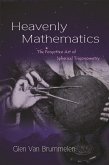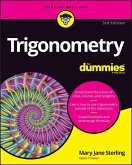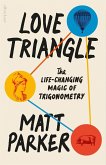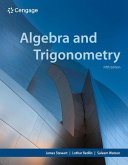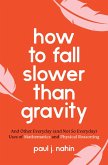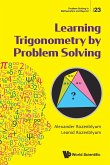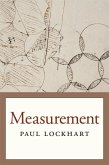James Stewart (McMaster University and University of Toronto), Lothar Redlin (Abington Campus Pennsylvania State University), Saleem Watson (Long Beach California State University)
Algebra and Trigonometry
James Stewart (McMaster University and University of Toronto), Lothar Redlin (Abington Campus Pennsylvania State University), Saleem Watson (Long Beach California State University)
Algebra and Trigonometry
- Gebundenes Buch
- Merkliste
- Auf die Merkliste
- Bewerten Bewerten
- Teilen
- Produkt teilen
- Produkterinnerung
- Produkterinnerung
Explains concepts simply and clearly, without glossing over difficult points. Comprehensive and evenly paced, this book provides complete coverage of the function concept, and integrates a significant amount of graphing calculator material to help students develop insight into mathematical ideas.
Andere Kunden interessierten sich auch für
![Heavenly Mathematics Heavenly Mathematics]() Glen Van BrummelenHeavenly Mathematics26,99 €
Glen Van BrummelenHeavenly Mathematics26,99 €![Trigonometry for Dummies Trigonometry for Dummies]() Mary Jane Sterling (Bradley University, Peoria, IL)Trigonometry for Dummies26,99 €
Mary Jane Sterling (Bradley University, Peoria, IL)Trigonometry for Dummies26,99 €![Love Triangle Love Triangle]() Matt ParkerLove Triangle33,99 €
Matt ParkerLove Triangle33,99 €![Algebra and Trigonometry Algebra and Trigonometry]() James Stewart (McMaster University and University of Toronto)Algebra and Trigonometry117,99 €
James Stewart (McMaster University and University of Toronto)Algebra and Trigonometry117,99 €![How to Fall Slower Than Gravity How to Fall Slower Than Gravity]() Paul NahinHow to Fall Slower Than Gravity25,99 €
Paul NahinHow to Fall Slower Than Gravity25,99 €![LEARNING TRIGONOMETRY BY PROBLEM SOLVING LEARNING TRIGONOMETRY BY PROBLEM SOLVING]() Alexander Rozenblyum (Usa City Univ Of New York)LEARNING TRIGONOMETRY BY PROBLEM SOLVING69,99 €
Alexander Rozenblyum (Usa City Univ Of New York)LEARNING TRIGONOMETRY BY PROBLEM SOLVING69,99 €![Measurement Measurement]() Paul LockhartMeasurement27,99 €
Paul LockhartMeasurement27,99 €-
-
-
Explains concepts simply and clearly, without glossing over difficult points. Comprehensive and evenly paced, this book provides complete coverage of the function concept, and integrates a significant amount of graphing calculator material to help students develop insight into mathematical ideas.
Hinweis: Dieser Artikel kann nur an eine deutsche Lieferadresse ausgeliefert werden.
Hinweis: Dieser Artikel kann nur an eine deutsche Lieferadresse ausgeliefert werden.
Produktdetails
- Produktdetails
- Verlag: Brooks/Cole / Cengage Learning EMEA
- 4. Aufl.
- Seitenzahl: 1136
- Erscheinungstermin: 13. Januar 2015
- Englisch
- Abmessung: 280mm x 222mm x 47mm
- Gewicht: 2359g
- ISBN-13: 9781305071742
- ISBN-10: 1305071743
- Artikelnr.: 41094643
- Herstellerkennzeichnung
- Libri GmbH
- Europaallee 1
- 36244 Bad Hersfeld
- gpsr@libri.de
- Verlag: Brooks/Cole / Cengage Learning EMEA
- 4. Aufl.
- Seitenzahl: 1136
- Erscheinungstermin: 13. Januar 2015
- Englisch
- Abmessung: 280mm x 222mm x 47mm
- Gewicht: 2359g
- ISBN-13: 9781305071742
- ISBN-10: 1305071743
- Artikelnr.: 41094643
- Herstellerkennzeichnung
- Libri GmbH
- Europaallee 1
- 36244 Bad Hersfeld
- gpsr@libri.de
James Stewart received the M.S. degree from Stanford University and the Ph.D. from the University of Toronto. After two years as a postdoctoral fellow at the University of London, he became Professor of Mathematics at McMaster University. His research has been in harmonic analysis and functional analysis. Stewart's books include a series of high school textbooks as well as a best-selling series of calculus textbooks published by Cengage Learning. He is also co-author, with Lothar Redlin and Saleem Watson, of a series of college algebra and precalculus textbooks. Translations of his books include those into Spanish, Portuguese, French, Italian, Korean, Chinese, Greek, Indonesian and Japanese. A talented violinist, Stewart was concertmaster of the McMaster Symphony Orchestra for many years and played professionally in the Hamilton Philharmonic Orchestra. He has given more than 20 talks worldwide on mathematics and music. Stewart was named a Fellow of the Fields Institute in 2002 and was awarded an honorary D.Sc. in 2003 by McMaster University. The library of the Fields Institute is named after him. The James Stewart Mathematics Centre was opened in October, 2003, at McMaster University.
Preface.To the Student.Prologue: Principles of Problem Solving.P. PREREQUISITES. P1. Modeling the Real-World with Algebra. P2. The Real Numbers. P3. Integer Exponents and Scientific Notation. P4. Rational Exponents and Radicals.P5. Algebraic Expressions. P6. Factoring. P7. Rational Expressions. P8. Solving Basic Equations. P9. Modeling with Equations. Chapter P Review. Chapter P Test.FOCUS ON MODELING: MAKING THE BEST DECISIONS.1. EQUATIONS AND GRAPHS.1.1 The Coordinate Plane. 1.2 Graphs of Equations in Two Variables; Circles. 1.3 Lines. 1.4 Solving Quadratic Equations. 1.5 Complex Numbers. 1.6 Solving Other Types of Equations. 1.7 Solving Inequalities. 1.8 Solving Absolute Value Equations and Inequalities. 1.9 Solving Equations and Inequalities Graphically. 1.10 Modeling Variations. Chapter 1 Review. Chapter 1 Test.FOCUS ON MODELING: Fitting Lines to Data.2. FUNCTIONS.Chapter Overview.2.1 Functions. 2.2 Graphs of Functions. 2.3 Getting Information from the Graph of a Function. 2.4 Average Rate of Change of a Function. 2.5 Linear Functions and Models. 2.6 Transformations of Functions. 2.7 Combining Functions. 2.8 One-to-One Functions and Their Inverses. Chapter 2 Review. Chapter 2 Test.FOCUS ON MODELING: MODELING WITH FUNCTIONS.3. POLYNOMIAL AND RATIONAL FUNCTIONS.Chapter Overview. 3.1. Quadratic Functions and Models. 3.2 Polynomial Functions and Their Graphs. 3.3 Dividing Polynomials. 3.4 Real Zeros of Polynomials. 3.5 Complex Zeros and the Fundamental Theorem of Algebra. 3.6 Rational Functions. 3.7 Polynomial and Rational Inequalities. Chapter 3 Review. Chapter 3 Test.FOCUS ON MODELING: FITTING POLYNOMIAL CURVES TO DATA.4. EXPONENTIAL AND LOGARITHMIC FUNCTIONS.Chapter Overview. 4.1 Exponential Functions. 4.2 The Natural Exponential Function. 4.3 Logarithmic Functions. 4.4 Laws of Logarithms. 4.5 Exponential and Logarithmic Equations. 4.6 Modeling with Exponential Functions. 4.7 Logarithmic Scales. Chapter 4 Review. Chapter 4 Test.FOCUS ON MODELING: FITTING EXPONENTIAL AND POWER CURVES TO DATA. 5. TRIGONOMETRIC FUNCTIONS: RIGHT TRIANGLE APPROACH.Chapter Overview.5.1 Angle Measure.5.2 Trigonometry of Right Triangles.5.3 Trigonometric Functions of Angles. 5.4 Inverse Trigonometric Functions and Triangles. 5.5 The Law of Sines. 5.6 The Law of Cosines. 5.7 Chapter 5 Review. Chapter 5 Test.FOCUS ON MODELING: SURVEYING.1.TRIGONOMETRIC FUNCTIONS: UNIT CIRCLE APPROACH.Chapter Overview.6.1 The Unit Circle. 6.2 Trigonometric Functions of Real Numbers. 6.3 Trigonometric Graphs. 6.4 More Trigonometric Graphs. 6.5 Inverse Trigonometric Functions and Their Graphs. 6.6 Modeling Harmonic Motion. Chapter 6 Review. Chapter 6 Test.FOCUS ON MODELING: FITTING SINUSOIDAL CURVES TO DATA.7. CONIC SECTIONS.Chapter Overview.7.1 Trigonometric Identities. 7.2 Addition and Subtraction Formulas. 7.3 Double-Angle, Half-Angle, and Sum-Product Formulas. 7.4 Basic Trigonometric Equations. 7.5 More Trigonometric Equations. Chapter 7 Review. Chapter 7 Test.FOCUS ON MODELING: TRAVELING AND STANDING WAVES.8. POLAR COORDINATES AND PARAMETRIC EQUATIONS.Chapter Overview. 8.1 Polar Coordinates. 8.2 Graphs of Polar Equations. 8.3 Polar Form of Complex Numbers; De Moivre's Theorem. 8.4 Plane Curves and Parametric Equations. Chapter 8 Review. Chapter 8 Test.FOCUS ON MODELING: THE PATH OF A PROJECTILE.9. VECTORS IN TWO AND THREE DIMENSIONS.Chapter Overview. 9.1 Vectors in Two Dimensions. 9.2 The Dot Product. 9.3 Three-Dimensional Coordinate Geometry. 9.4 Vectors in Three Dimensions. 9.5 The Cross Product. 9.6 Equations of Lines and Planes. Chapter 9 Review. Chapter 9 Test.FOCUS ON MODELING: VECTOR FIELDS.10. SYSTEMS OF EQUATIONS AND INEQUALITIES.10.1 Systems of Linear Equations in Two Variables. 10.2 Systems of Linear Equations in Several Variables. 10.3 Partial Fractions. 10.4 Systems of Nonlinear Equations. 10.5 Systems of Inequalities. Chapter 10 Review. Chapter 10 Test.FOCUS ON MODELING: LINEAR PROGRAMMING.11. MATRICES AN
Preface.To the Student.Prologue: Principles of Problem Solving.P. PREREQUISITES. P1. Modeling the Real-World with Algebra. P2. The Real Numbers. P3. Integer Exponents and Scientific Notation. P4. Rational Exponents and Radicals.P5. Algebraic Expressions. P6. Factoring. P7. Rational Expressions. P8. Solving Basic Equations. P9. Modeling with Equations. Chapter P Review. Chapter P Test.FOCUS ON MODELING: MAKING THE BEST DECISIONS.1. EQUATIONS AND GRAPHS.1.1 The Coordinate Plane. 1.2 Graphs of Equations in Two Variables; Circles. 1.3 Lines. 1.4 Solving Quadratic Equations. 1.5 Complex Numbers. 1.6 Solving Other Types of Equations. 1.7 Solving Inequalities. 1.8 Solving Absolute Value Equations and Inequalities. 1.9 Solving Equations and Inequalities Graphically. 1.10 Modeling Variations. Chapter 1 Review. Chapter 1 Test.FOCUS ON MODELING: Fitting Lines to Data.2. FUNCTIONS.Chapter Overview.2.1 Functions. 2.2 Graphs of Functions. 2.3 Getting Information from the Graph of a Function. 2.4 Average Rate of Change of a Function. 2.5 Linear Functions and Models. 2.6 Transformations of Functions. 2.7 Combining Functions. 2.8 One-to-One Functions and Their Inverses. Chapter 2 Review. Chapter 2 Test.FOCUS ON MODELING: MODELING WITH FUNCTIONS.3. POLYNOMIAL AND RATIONAL FUNCTIONS.Chapter Overview. 3.1. Quadratic Functions and Models. 3.2 Polynomial Functions and Their Graphs. 3.3 Dividing Polynomials. 3.4 Real Zeros of Polynomials. 3.5 Complex Zeros and the Fundamental Theorem of Algebra. 3.6 Rational Functions. 3.7 Polynomial and Rational Inequalities. Chapter 3 Review. Chapter 3 Test.FOCUS ON MODELING: FITTING POLYNOMIAL CURVES TO DATA.4. EXPONENTIAL AND LOGARITHMIC FUNCTIONS.Chapter Overview. 4.1 Exponential Functions. 4.2 The Natural Exponential Function. 4.3 Logarithmic Functions. 4.4 Laws of Logarithms. 4.5 Exponential and Logarithmic Equations. 4.6 Modeling with Exponential Functions. 4.7 Logarithmic Scales. Chapter 4 Review. Chapter 4 Test.FOCUS ON MODELING: FITTING EXPONENTIAL AND POWER CURVES TO DATA. 5. TRIGONOMETRIC FUNCTIONS: RIGHT TRIANGLE APPROACH.Chapter Overview.5.1 Angle Measure.5.2 Trigonometry of Right Triangles.5.3 Trigonometric Functions of Angles. 5.4 Inverse Trigonometric Functions and Triangles. 5.5 The Law of Sines. 5.6 The Law of Cosines. 5.7 Chapter 5 Review. Chapter 5 Test.FOCUS ON MODELING: SURVEYING.1.TRIGONOMETRIC FUNCTIONS: UNIT CIRCLE APPROACH.Chapter Overview.6.1 The Unit Circle. 6.2 Trigonometric Functions of Real Numbers. 6.3 Trigonometric Graphs. 6.4 More Trigonometric Graphs. 6.5 Inverse Trigonometric Functions and Their Graphs. 6.6 Modeling Harmonic Motion. Chapter 6 Review. Chapter 6 Test.FOCUS ON MODELING: FITTING SINUSOIDAL CURVES TO DATA.7. CONIC SECTIONS.Chapter Overview.7.1 Trigonometric Identities. 7.2 Addition and Subtraction Formulas. 7.3 Double-Angle, Half-Angle, and Sum-Product Formulas. 7.4 Basic Trigonometric Equations. 7.5 More Trigonometric Equations. Chapter 7 Review. Chapter 7 Test.FOCUS ON MODELING: TRAVELING AND STANDING WAVES.8. POLAR COORDINATES AND PARAMETRIC EQUATIONS.Chapter Overview. 8.1 Polar Coordinates. 8.2 Graphs of Polar Equations. 8.3 Polar Form of Complex Numbers; De Moivre's Theorem. 8.4 Plane Curves and Parametric Equations. Chapter 8 Review. Chapter 8 Test.FOCUS ON MODELING: THE PATH OF A PROJECTILE.9. VECTORS IN TWO AND THREE DIMENSIONS.Chapter Overview. 9.1 Vectors in Two Dimensions. 9.2 The Dot Product. 9.3 Three-Dimensional Coordinate Geometry. 9.4 Vectors in Three Dimensions. 9.5 The Cross Product. 9.6 Equations of Lines and Planes. Chapter 9 Review. Chapter 9 Test.FOCUS ON MODELING: VECTOR FIELDS.10. SYSTEMS OF EQUATIONS AND INEQUALITIES.10.1 Systems of Linear Equations in Two Variables. 10.2 Systems of Linear Equations in Several Variables. 10.3 Partial Fractions. 10.4 Systems of Nonlinear Equations. 10.5 Systems of Inequalities. Chapter 10 Review. Chapter 10 Test.FOCUS ON MODELING: LINEAR PROGRAMMING.11. MATRICES AN


